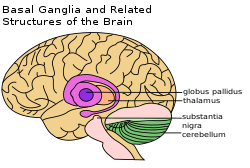Photo of a male tabby
Cat intelligence is the capacity of the domesticated cat
to solve problems and adapt to its environment. Researchers have also
shown feline intelligence to include the ability to acquire new behavior
that applies previously learned knowledge to new situations,
communicating needs and desires within a social group, and responding to
training cues.
The brain of a cat
Brain size
The brain of the domesticated cat is about five centimetres (2.0 in) long, and weighs 25–30 g (0.88–1.06 oz). If a typical cat is taken to be 60 cm (24 in) long with a weight of 3.3 kg (7.3 lb), then the brain would be at 0.91% of its total body mass, compared to 2.33% of total body mass in the average human. Within the encephalization quotient proposed by Jerison in 1973, values above 1 are classified big brained, while values lower than 1 are small brained. The domestic cat is attributed a value of between 1–1.71 relative to human value that is 7.44–7.8. The largest brains in the Felidae family are those of the tigers in Java and Bali, of which the largest relative brain size within the panthera is the tigris. It is debated whether there exists a causal relationship between brain size and intelligence in vertebrates. Correlations have been shown between these factors in a number[] of experiments. However, correlation does not imply causation.
Most experiments involving the relevance of brain size to intelligence
hinge on the assumption that complex behavior requires a complex (and
therefore intelligent) brain; however, this connection has not been
consistently demonstrated.
The surface area of a cat's cerebral cortex is approximately 83 cm2 (13 in2) whereas the human brain has a surface area of about 2,500 cm2 (390 in2). Furthermore, a theoretical cat weighing 2.5 kg (5.5 lb) has a cerebellum weighing 5.3 g (0.19 oz), 0.17% of the total weight.
Brain structures
A cat's brain
According to researchers at Tufts University School of Veterinary
Medicine, the physical structure of the brains of humans and cats is
very similar. The human brain and the cat brain both have cerebral cortices with similar lobes.
The number of cortical neurons contained in the brain of the cat is reported to be 763 million. Area 17 of the visual cortex was found to contain about 51,400 neurons per mm3. Area 17 is the primary visual cortex.
Both human and feline brains are gyrencephalic, i.e. they have a surface folding.
Analyses of cat brains have shown they are divided into many
areas with specialized tasks that are extremely interconnected and share
sensory information in a kind of hub-and-spoke network,
with a large number of specialized hubs and many alternative paths
between them. This exchange of sensory information allows the brain to
construct a complex perception of the real world and to react to and
manipulate its environment.
The thalamus of the cat includes a hypothalamus, an epithalamus, a lateral geniculate nucleus, and additional secondary nuclear structures.
Secondary brain structures
The domestic cat brain also contains the hippocampus, amygdala, frontal lobes (which comprise 3 to 3.5% of the total brain in cats compared to about 25% in humans), corpus callosum, anterior commissure, pineal gland, caudate nucleus, septal nuclei and midbrain.
Neuroplasticity
Grouse et al. 1979 ascertained the neuroplasticity of kittens' brains, with respect to control of visual stimulus correlated with changes in RNA structures. In a later study, it was found that cats possess visual-recognition memory, and have flexibility of cerebral encoding from visual information.
Brain and diet
A cognitive support diet for felines is a food that is formulated to
improve mental processes like attention, short and long-term memory,
learning, and problem solving. Claims for cognitive support appear on a
number of kitten formulations to help with brain development, as well as
diets aimed at seniors to help prevent cognitive disorders. These diets
typically focus on supplying Omega-3 fatty acids, omega-6 fatty acids, taurine, vitamins, and other supporting supplements that have positive effects on cognition.
The omega-3 fatty acids are a key nutrient in cognition for
felines. They are essential for felines as they cannot be synthesized
naturally and must be obtained from the diet. Omega-3 fatty acids that support brain development and function are alpha-linolenic acid, docosahexaenoic acid (DHA) and eicosapentaenoic acid (EPA). Fish oils, fish and other marine sources provide a very rich source of DHA and EPA. Alpha-linolenic acid can be acquired from oils and seeds.
Omega-6 fatty acids are also needed in feline cognition diets.
The important omega-6 fatty acid that plays a role in brain support and
cognition is arachidonic acid. Arachidonic acid or AA is found in animal sources such as meat and eggs.
AA is required in cat diets, as felines convert insignificant amounts
of it from linoleic acid due to the limited delta-6 desaturase. Like DHA, arachidonic acid is often found in the brain tissues of cats and seems to have a supporting role in brain function. In a 2000 study completed by Contreras et al., it was found that DHA and AA made up 20% of the fatty acids in the mammalian brain. Arachidonic acid makes up high amounts in the membrane of most cells and has many pro-inflammatory actions.
Taurine
is an amino acid, which is essential in cat diets due to their low
capacity to synthesize it. Because taurine has the ability to cross the blood–brain barrier in the brain, it has been found to have a role in many neurological functions, especially in the visual development. Without taurine, felines can have an abnormal morphology in the cerebellum and visual cortex.
When cats were fed a diet deficient in taurine, this leads to a
decrease in the concentration of taurine in the retina of the eye. This
results in deterioration of the photoreceptors, followed by complete
blindness.
Choline is a water-soluble nutrient that prevents and improves epilepsy and cognitive disorders. Supplementation is part of therapy for cats with seizures and Feline cognitive dysfunction, despite this treatment being mostly based on anecdotal evidence and research done on dogs. It is the precursor to nerve chemicals like dopamine and acetylcholine, making it important for proper functioning of the nervous system.
Intelligence
A sleeping cat. Much like humans, cats experience complex dreams while sleeping, involving long sequences of events that can be retained and recalled.
Intelligence through behavioural observation is defined as a composite of skills and abilities.
The WAIS test is a measure of intelligence in adult homo sapiens. The test scores on four criteria: verbal comprehension, perceptual organization, working memory and processing speed. In a comparative evaluation from WAIS criteria, cats are generally fair in intelligence.
In controlled experiments, cats showed that they had fully developed concepts of object permanence,
meaning that sensorimotor intelligence is completely developed in cats.
For human infants, tests involving multiple invisible displacements of
an object are used to assess the beginning of mental representation in
the sixth and last stage of sensorimotor intelligence. The cats'
searches on these tasks were consistent with representation of an
unsensed object and fully developed sensorimotor intelligence. The working memory for object permanence of the domesticated cat is surmised from experiment as being of 16 hours.
In 2009, an experiment was conducted where cats could pull on a
string to retrieve a treat under a plastic screen. When presented with
one string, cats had no trouble getting the treats, but when presented
with multiple strings, some of which were not connected to treats, the
cats were unable to consistently choose the correct strings, leading to
the conclusion that cats do not understand cause and effect in the same
way that humans do.
Cats have complex dreams while sleeping, retaining and recalling
long sequences of events while they are asleep, as many other animals
do. A dreaming cat will usually have rapid, uncontrolled facial, whisker, paw, and abdominal movements.
Memory
Taken as a whole, cats have excellent memories.
In experimental conditions, the memory of a cat was demonstrated as
having an information-retention or recall, of a duration totalling as
much as 10 years. However, relationships with humans, individual differences in intelligence,
and age may all affect memory. Cats easily adapt to their current
environment because they can adapt their memories of past environments
throughout their lives.
In kittens
The period during which the cat is a kitten
is the time when the cat learns and memorizes survival skills, which
are acquired through observation of their mothers and playing with other
cats. Playing, in fact, constitutes more than fun for a kitten, for it
is essential for ranking social order, building hunting skills, and
generally exercising for the adult roles.
The first two to seven weeks are a particularly critical time for
kittens, for it is during this period that they bond with other cats.
It has been suspected that without any human contact during this time,
the cat would forever mistrust humans.
In older cats
Just as in humans, advancing age may affect memory
in cats. Some cats may experience a weakening of both learning ability
and memory that affects them adversely in ways similar to those
occurring in poorly aging humans. A slowing of function is normal, and
this includes memory. Aging may affect memory by changing the way their
brain stores information and by making it harder to recall stored
information. Cats lose brain cells as they age, just as humans do.
The older the cat, the more these changes can affect its memory. There
have been no studies done on the memories of aging cats, but there is
some speculation that, just like people, short-term memory is more affected by aging. In one test of where to find food, cats' short-term memory lasted about 16 hours.
Diseases
Disease, such as feline cognitive dysfunction (FCD) – a condition similar to Alzheimer's disease
in humans – could also affect cat memory. Symptoms of FCD include
disorientation, reduced social interaction, sleep disturbances, and loss
of house training. FCD causes degenerative changes in the brain that
are the source of the functional impairment.
Learning capacities
Edward Thorndike
conducted some key experiments on cat's learning capacity. In one of
Thorndike's experiments, cats were placed in various boxes approximately
20 in × 15 in × 12 in (51 cm × 38 cm × 30 cm) with a door opened by
pulling a weight attached to it. The cats were observed to free
themselves from the boxes by "trial and error with accidental success."
Though cats did perform worse on occasion, Thorndike generally found
that as cats continued the trials, the time taken to escape the boxes
decreased in most cases. Thorndike considered the cat to follow the law of effect,
which states that responses followed by satisfaction (i.e. a reward)
become more likely responses to the same stimulus in the future.
Thorndike was generally skeptical of the presence of intelligence in
cats, criticising sources of the contemporary writing of the sentience
of animals as "partiality in deductions from facts and more especially
in the choice of facts for investigation."
An experiment was done to identify possible observational learning
in kittens. Kittens that were able to observe their mothers performing
an experimentally organised act were able to perform the same act sooner
than kittens that had observed a non-related adult cat, and sooner than
the ones who, being placed in trial and error conditions, observed no
other cat performing the act.
Domestication effects
Cat intelligence study is mostly from consideration of the domesticated
cat. The process of domestication has allowed for closer observation of
cat behaviour and in the increased incidence of interspecies
communication,
and the inherent plasticity of the cat's brain has become apparent as
the number of studies in this have increased scientific insight. Changes
in the genetic structure of a number of cats have been identified
as a consequence of both domestication practises and the activity of
breeding, so that the species has undergone genetic evolutionary change
due to human selection
(although this human selection has been coupled with an initial
naturally occurring selective set of cats possessing characteristics
desirable for the sharing of human habitation and living in Neolithic urban environments).
Cats' intelligence may have increased during their semi-domestication: urban living may have provided an enriched and stimulating environment requiring novel adaptive behaviours. This scavenging behaviour would only have produced slow changes in evolutionary terms, but such changes would have been comparable to the changes to the brain of early primitive hominids who co-existed with primitive cats (like, for example, Machairodontinae, Megantereon and Homotherium) and adapted to savannah conditions.
Cat's urban living is, however, unlikely to indefinitely improve the
animal's intelligence: consider the fossil-based family tree of
placental mammals
above; the feline line diverged many years previously from the primate
line; the cat both feral and domesticated is likely to be maintained in
an evolutionary stasis by its niche position in the food web.
Exploitation possibilities
Cats are known to be trained to perform as circus animals. An example of this is The Yuri Kuklachev Cat Theatre based in Moscow, the owner of which has been training cats for many years to perform a range of circus-style tricks.
In artificial intelligence
In November 2009, scientists claimed to simulate a cat's brain using a supercomputer containing 24,576 processors.
This experiment did not simulate the function of the individual neurons
in the brain, nor their synaptic patterns. It was intended to
demonstrate that the problem of simulating a biological brain could be
scaled to very large supercomputer platforms. However, the approach has been criticised as flawed.
There are a number of reasons for why the cat brain is a goal of
computer simulations. Cats are familiar and easily kept animals, so the
physiology of cats has been particularly well studied. The physical
structures of human brains and cat brains are very similar. Cats, like humans, have binocular vision that gives them depth perception. Moreover, trying to build artificial mammal brains advances the research of both neuroscience and artificial intelligence.












